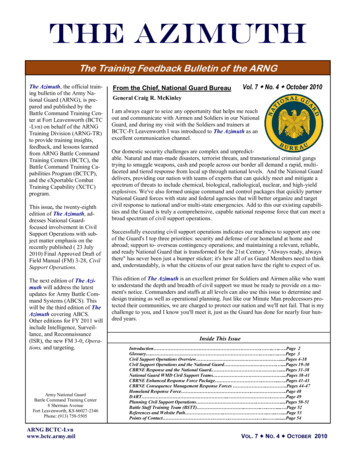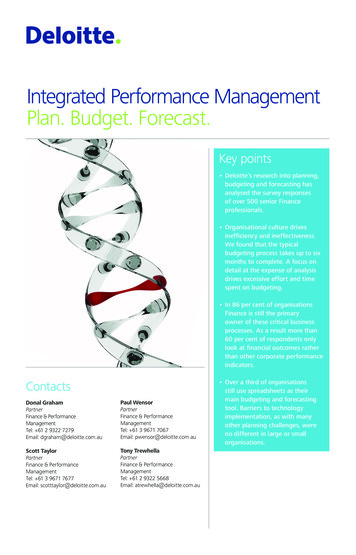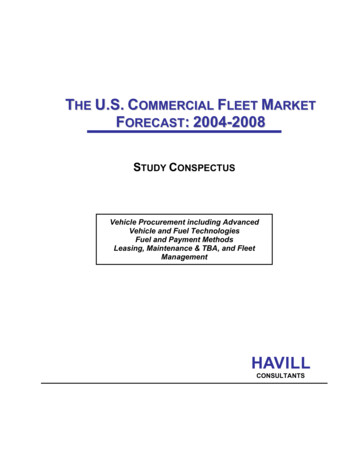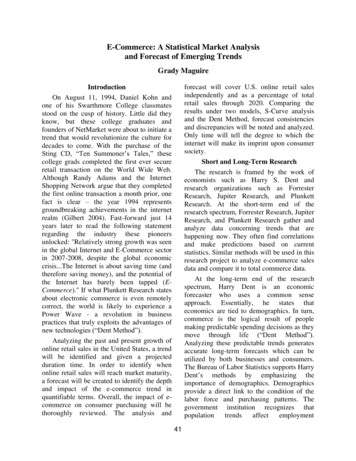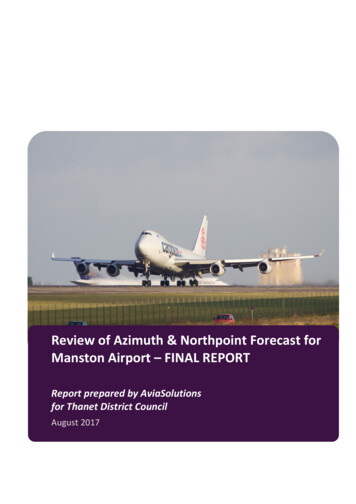
Transcription
Review of Azimuth & Northpoint Forecast forManston Airport – FINAL REPORTReport prepared by AviaSolutionsfor Thanet District CouncilAugust 2017
Disclaimer of LiabilityThis publication provides general information and should not be used or taken as business, financial, tax, accounting, legalor other advice, or relied upon in substitution for the exercise of your independent judgment. For your specific situation orwhere otherwise required, expert advice should be sought. Although Avia Solutions Limited or any of its affiliates (together,“Avia”) believes that the information contained in this publication has been obtained from and is based upon sources Aviabelieves to be reliable, Avia does not guarantee its accuracy and it may be incomplete or condensed. Avia makes norepresentation or warranties of any kind whatsoever in respect of such information. Avia accepts no liability of any kind forloss arising from the use of the material presented in this publication.Copyright 2017 the General Electric Company. All rights reserved.“GE,” “General Electric Company,” “General Electric,” GECAS”, “GE Capital Aviation Services Limited”, “AviaSolutions,” the GELogo, and various other marks and logos used in this publication are registered trademarks, trade names and service marksof the General Electric Company. No part of this publication or any trademark or trade name may be used without the writtenpermission of the General Electric Company.
Thanet District Council – Manston AirportContents1.1.Context52.1.Volume I – Demand in the south east of the UK72.1.1.Overview72.1.2.Requirement for additional airport capacity in the UK and South East72.1.3.Can Manston Airport relieve pressure on the UK aviation system, and beconsidered a nationally significant infrastructure project?2.2.2.3.Volume II – A qualitative study of potential Conclusions102.2.4.Additional Consideration Conclusion11Volume III – The forecast122.3.1.Overview122.3.2.Forecast Results122.3.3.Forecast Review132.3.4.Infrastructure Review142.4.Conclusions3.1.The Shortcomings of the AviaSolutions Report and an Overview of RSP’sProposals for Airport Operation at Manston15163.1.1.Summary of Evidence163.1.2.AviaSolutions Review163.1.3.Manston Airport Benchmarks163.1.4.Freight Projections173.1.5.Cross Channel Transhipments183.1.6.Substitutable Bellyhold Capacity193.1.7.Additional Comments20P a g e 3
Thanet District Council – Manston AirportExecutive SummaryAviaSolutions has reviewed the cases for Manston Airport prepared by Azimuth Associates and Northpointon behalf of RiverOak Strategic Partners in February 2017. Azimuth’s case for Manston Airport is based onan assessment of the airport’s ability to capture a significant share of the air and road freight market inLondon and the south east. Northpoint’s forecast is based on a similar premise coupled with theintroduction of multiple aviation related auxiliary activities.AviaSolutions’ view is that the Azimuth and Northpoint forecasts both represent a highly ambitious outlookfor air freight volume at Manston Airport and the likelihood of the forecasts being realised is very low. Wedo believe that there may be scope for the reintroduction of passenger services, broadly consistent withthe volume projections set out in AviaSolutions report, although this alone would not generate sufficientrevenue to develop profitable operations.Neither report puts forward a sufficiently credible case, nor provides the evidence, for AviaSolutions tochange its views on the financial viability of Manston Airport.We remain of the view that whilst Heathrow Airport continues to offer substantial freight capacity to anextensive global network, and Stansted Airport offers capacity for air freighter movements, the London airfreight market has capacity to grow without the re-introduction of capacity at Manston Airport. FreightForwarders have invested heavily in infrastructure around the UK’s core cargo airports and carriers havedeveloped their networks as such. Without clear value drivers that support relocating services to ManstonAirport, the case remains to be made that demand exists for a freight facility at Manston Airport.Provision of capacity alone is no guarantee of financial success, a view reinforced by the empirical evidenceof multiple failed attempts to develop profitable aviation operations at Manston Airport.P a g e 4
Thanet District Council – Manston AirportIntroduction1.1. ContextAviaSolutions (“Avia”) has been commissioned by Thanet District Council (“TDC”) to undertake a detailedanalysis of the reports prepared by Sally Dixon of Azimuth Associates (“Azimuth”) for RiverOak in February 2017.-Volume I – Demand in the south east of the UK-Volume II – A qualitative study of potential demand-Volume III – The forecastAdditionally, a Representation to the Local Plan was produced, entitled “The Shortcomings of the AviaSolutionsReport and an Overview of RSP’s Proposals for Airport Operation at Manston” prepared for RiverOak StrategicPartners by Chris Cain of Northpoint Aviation Services (“Northpoint”). The Representation is largely a repeat ofthe Appeal prepared on behalf of RiverOak Strategic Partners, which has already been the subject of review byAviaSolutions in March 2017. In the second part of this document, AviaSolutions presents the earlier critique ofNorthpoint’s appeal, updated to reflect some additional airport benchmarks included in the Representation.Avia has previously been engaged by TDC to assess the financial viability of Manston Airport. The report wascompleted in September 2016 and concluded that it is unlikely that the airport would be financially viable in thelong term, and almost certainly not possible in the period to 2031. This conclusion was reached afterinterviewing key stakeholders and industry experts and analysing extensive market data. In the UK, today andinto the foreseeable future, there is excess market capacity for air freighter movements due to the strength ofthe bellyhold market at Heathrow, which continues to grow despite the statutory movement cap. Stansted andEast Midlands, which both are much more centrally located than Manston Airport, provide ample capacity forair freighter movements in the short to medium term, by which time we expect the south east market tointroduce new capacity at Heathrow.Azimuth Associates is an independent aviation and business research consultancy providing analysis andinsight into the future direction and potential for airport development around the world (source:www.azimuthassociates.co.uk).In March 2017, RiverOak Investment Corp., LLC announced that RiverOak Strategic Partners Limited, a newlyUK-registered joint venture company had acquired all rights and interests and has assumed full financial andoperational responsibility for the Development Consent Order (DCO) with respect to Manston Airport and thefuture reopening and operation of the airport. The new operating company, which is not affiliated with RiverOakInvestment Corp., LLC, will pursue the DCO application to acquire and reinstate Manston as a fully operationalP a g e 5
Thanet District Council – Manston Airportairport and if successful, will be operated, owned and managed completely independently of RiverOakInvestment Corp., LLC (source: www.riveroakic.com/news.html).The stated objective of the Azimuth report is to consider whether there is a compelling case in the public interestto create a freight focused facility at Manston Airport. The report contends that the decision for Manston Airportto be returned to operational use hinges on three key questions:1.Does the UK require additional airport capacity in order to meets its political, economic, and social aims?2.Should this additional capacity be located in the south east of England?3.Can Manston Airport, with investment from RiverOak, relieve pressure on the UK network and meetthe requirement of a nationally significant infrastructure project?The report considers a range of data sources and publications to answer the above questions, concluding thatthere is an overwhelming case to support planning and development at Manston Airport.In this review of the Azimuth and Northpoint reports, Avia considers the supporting evidence, rationale and thecase put forward by the authors to inform subsequent discussion on the future of Manston Airport.P a g e 6
Thanet District Council – Manston AirportREVIEW OF AZIMUTH ASSOCIATESREPORT2.1. Volume I – Demand in the south east of the UK2.1.1. OverviewThe first document prepared by Azimuth (Volume I) sets out an overview of airport capacity in the UK, focussingon the south east of England. This is followed by a review of air freight capacity in the south east that may fulfilexcess air freight demand in the short to medium term. The report proceeds with an outline of the politicalcontext for UK aviation decision making before focussing on Manston Airport’s potential as a freight focussedairport and the various external influences on the airport’s future.The report by Azimuth draws on a range of data sources and publications although there are several aspects ofthe report which we believe merit further scrutiny and challenge which are set out below.2.1.2. Requirement for additional airport capacity in the UK and SouthEastThere is little to add with regards to Azimuth’s assessment of the lack of capacity in the UK airport sector andits impact on the UK economy (Chapter 2). Supporting information is drawn from extensive material availableon the subject including a range of data sources referred to in the Airports Commission publication on UK airportcapacity, July 2015. We do note however that the conclusions drawn from the research are centred on airpassenger traffic rather than air freight.In Chapter 3 of Volume I, the focus of the report shifts to air freight, drawing on information from Boeing andAirbus forecasts which consider the global aviation markets and intercontinental trends in production andsupply, citing long term air freight growth rates of 4.2% and 4.0% respectively. Azimuth further note that the UKair freight market has become constrained at London airports, with the implication that a lack of air freightcapacity is one of the causal factors behind the stagnation of the UK air freight market, the annual performanceof which is set out below.UK Air Freight ('000 62016 Vs15CAGR(2006-16)London 8201,8061,8693.5%0.9%UK 3042,2992,3853.7%0.0%Source: CAAP a g e 7
Thanet District Council – Manston AirportWe would also highlight the excess capacity that exists in the UK market today which supported air freightgrowth of 3.7% in 2016, and in the London market which increased by 3.5%. Stansted Airport (the second largestUK airport by freighter ATMs after East Midlands Airport) increased freight tonnage by 7.3%, though utilised onlyaround half of the airport’s statutory freighter movement cap (20,500 per annum). Further, load factors fromHeathrow in bellyhold remain well below constrained levels. Azimuth has not commented on the market’sability to continue driving freight throughput out of the existing infrastructure as evidenced by the above growthin 2016.A key observation is Azimuth’s absence of comment on the uniqueness of the UK air freight market, particularlyin London. Only around 30% of UK air freight is carried on dedicated freighter aircraft, substantially lower thanthe global average, where 56% of revenue tonne kilometres (RTKs) are transported on freighter aircraft. This isat least in part due to the significant bellyhold capacity and network diversity available to exporters andimporters from an airport as large as Heathrow. The lack of excess air transport movement (ATM) capacity atHeathrow (480,000 annual movement cap) has led to a sustained increase in aircraft size, which increasesbellyhold capacity and keeps the price of bellyhold air freight low, relative to dedicated freighter based capacity.Around 35% of ATMs at Heathrow are widebody, long haul aircraft resulting in an average bellyhold cargocapacity of around 7-8 tonnes per aircraft and an extensive network of direct flights to destinations around theworld that is unrivalled by any other European airport.A central tenet of the Azimuth reports appears to be that the bellyhold and dedicated freighter markets aremutually exclusive, whereas the reality is that they are intrinsically linked and overlapping markets with someminor exceptions (low density bulk freight), and where price per kg plays a pivotal role in determining themovement of goods by shippers and freight forwarders. Bellyhold freight tends to be far more cost effective thanfreighters for an equivalent distance and density from Heathrow which, especially when coupled with theextensive network, ensures the predominance of Heathrow in the UK air freight market.P a g e 8
Thanet District Council – Manston Airport2.1.3. Can Manston Airport relieve pressure on the UK aviation system,and be considered a nationally significant infrastructure project?The Azimuth report concludes that the London Airports will be at capacity by 2030 based on the AirportsCommission findings. As noted earlier, the findings of this report relate mainly to passenger plus freightermovements, and AviaSolutions’ view is that excess cargo capacity (combining bellyhold and freighter capacity)will continue to exist in the south east of England beyond 2030.Azimuth put forward a case for the re-introduction of Manston Airport to relieve pressure on the London airportsystem. However, AviaSolutions view is that the provision of airfield and terminal capacity alone is not sufficientto develop financially viable air freight based airport operations as there must be a corresponding demandscenario to support such operations. In the long term, only if additional runway capacity is not delivered atHeathrow / Gatwick is there likely to be excess demand that will spill from the London system to ManstonAirport, but that is a very long term, risk-laden investment proposition.The stated objective of RiverOak is to develop an air freight focussed business at Manston Airport, but theprovision of capacity is not the determinant of profitability. It is AviaSolutions’ view that Azimuth’s report doesnot provide sufficient evidence of demand at Manston Airport from air freight operators to support the requiredinvestment in facilities and profit generation potential to re-establish Manston Airport as a going concern.Manston Airport continued to provide a gateway to the UK air freight market until ceasing operations in 2014.It is therefore difficult for Azimuth to argue that the UK air freight market has stagnated due to a lack of capacity,without also acknowledging that one of the providers of air freight capacity in the UK and south east marketduring this period (Manston Airport) was unable to attract sufficient cargo volume throughput to operateprofitably, leading to its eventual demise as a London based air freight focussed facility. The Azimuth report doesnot acknowledge nor address the fact that even if there has been a lack of air freight capacity in the UK andsouth east causing the cargo market to stagnate (a hypothesis that is not supported by Avia), the market stillchose not to utilise Manston Airport as a solution to this capacity shortfall.Overall, taking these issues into consideration, whilst the airport envisioned by inference from RiverOakStrategic Partners’ proposal would technically be capable of handling more than 10,000 freighter ATMs, it isAvia’s view that the demand would not exist at Manston Airport to support such a number of ATMs, and bydeduction, therefore Manston Airport would not serve to relieve pressure elsewhere on the aviation system.P a g e 9
Thanet District Council – Manston Airport2.2. Volume II – A qualitative study of potential demand2.2.1. OverviewThe second document prepared by Azimuth sets out an assessment of the expected demand for ManstonAirport as a freight hub for the south east of the UK. The objective is to provide a 20-year demand forecast forfreight and passenger movements based on a thorough review of the market, existing literature and stakeholderinterviews. The report contends that Manston Airport has the location, airspace, capacity potential and demandrequired to grant a DCO which would allow the redevelopment of the airport.Azimuth acknowledges the challenge of reliably forecasting freight demand and instead of extrapolating pasttrends seeks to establish a body of qualitative evidence to underpin the proposal to retain Manston Airport asa freight based airport serving London and the south east market. The report identifies specific opportunitiesfor Manston Airport based on constraints in the London airport market and aviation related activities whichcould improve the prospects of profitability at the airport.2.2.2. MethodologyThe report sets out an extensive review of the air freight market characteristics and the available air freightforecasting literature, acknowledging not only the lack of academic research into this subject but also thedifferences between forecasting cargo and passenger movements. The review concludes that instead ofadopting a mathematical model, a qualitative approach that gathers opinions from industry experts will allowareas of potential demand for Manston Airport to be identified and explored. There follows an outline of themethodology to identify and select interviewees and the freight related questions that would inform thedemand forecast model for Manston Airport.Chapter 5 sets out the stakeholder responses which are almost entirely favourable and present Manston Airportas a solution to the challenges caused by an air freight market operating in London’s highly congested air travelsystem. Chapter 6 provides a summary of these findings and their influence on expected freight and passengerdemand at Manston Airport, including sector and geographic market opportunities.2.2.3. ConclusionsThe report concludes with a summary of the stakeholder feedback which is considered to be an affirmation ofthe findings in Volume I, namely a significant and deteriorating lack of aircraft movement capacity in Londonand the south east. The report ends with statements outlining the implications of the research outcomes for UKaviation policymakers and RiverOak.P a g e 10
Thanet District Council – Manston AirportAvia’s assessment of this report is that it reflects a wider body of evidence that supports an urgent need foradditional movement capacity in the London air travel market. Similarly, we would concur with the view that UKaviation policymakers do not have the same depth of knowledge about the air freight market that they do aboutthe air passenger travel market and a National Air Freight Demand Model would be a useful development.The findings of the stakeholder interviews do however contrast markedly with Avia’s own findings, published byThanet District Council in September 2016 (“Commercial Viability of Manston Airport”, Chapter 6.3). Avia’sprimary research indicated that whilst Manston Airport offered some service quality and processing timebenefits, the cargo market did not value these over the remote geographic location which is 3/4 surrounded bythe English Channel. When considered against its competitors such as Stansted Airport and East MidlandsAirport, the location of Manston Airport and its relative access to the south and south east of the UK is inferior.Source: Google2.2.4. Additional ConsiderationsWe would also add that the perceived advantages and opportunities that exist for Manston Airport reported byAzimuth are not new. This is not to underestimate the value of introducing these non-core activities at theairport, more to highlight the fact tha
In March 2017, RiverOak Investment Corp., LLC announced that RiverOak Strategic Partners Limited, a newly UK-registered joint venture company had acquired all rights and interests and has assumed full financial and operational responsibility for the Development Consent Order (DCO) with respect to Manston Airport and the

